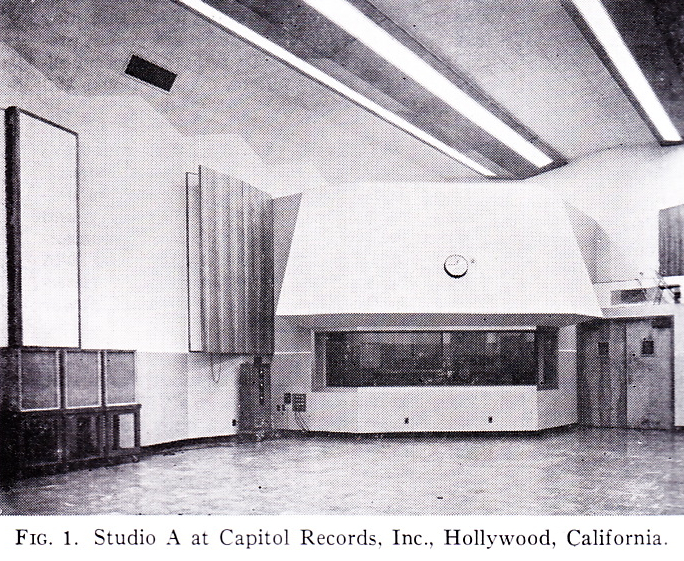
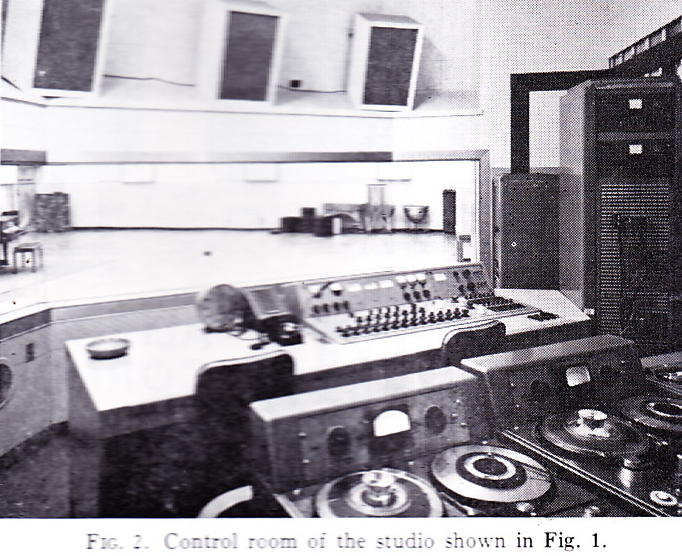 Above: the live room and control room of Capitol A, Los Angeles, circa late 1950’s.
Above: the live room and control room of Capitol A, Los Angeles, circa late 1950’s.
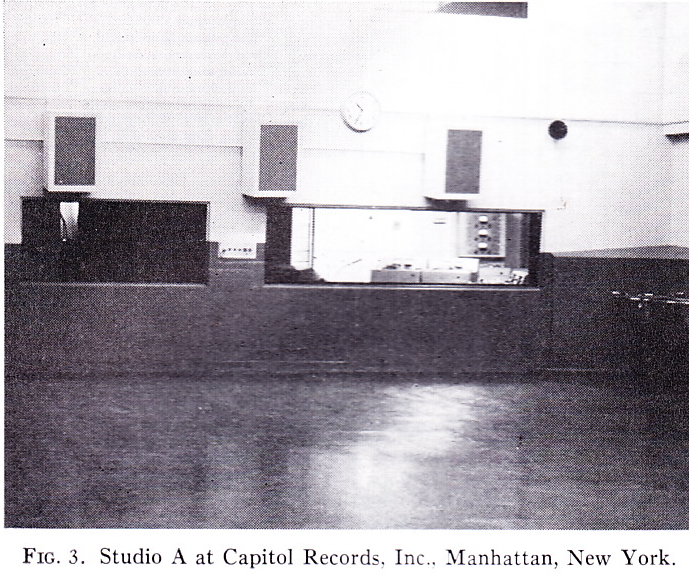
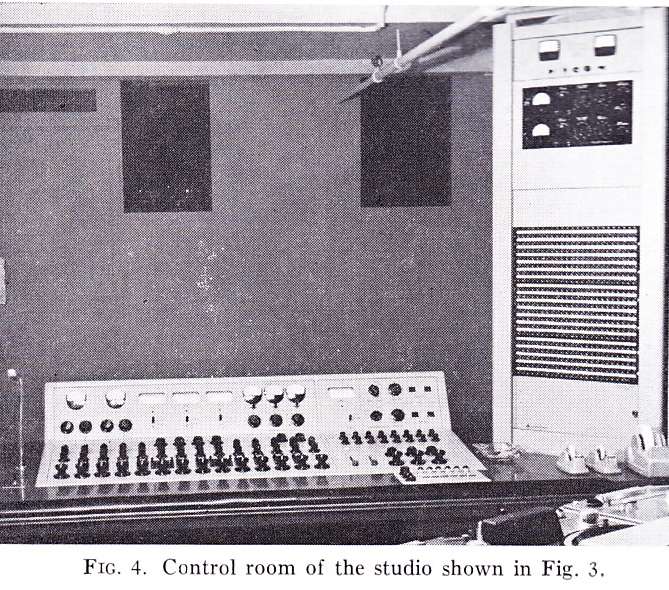
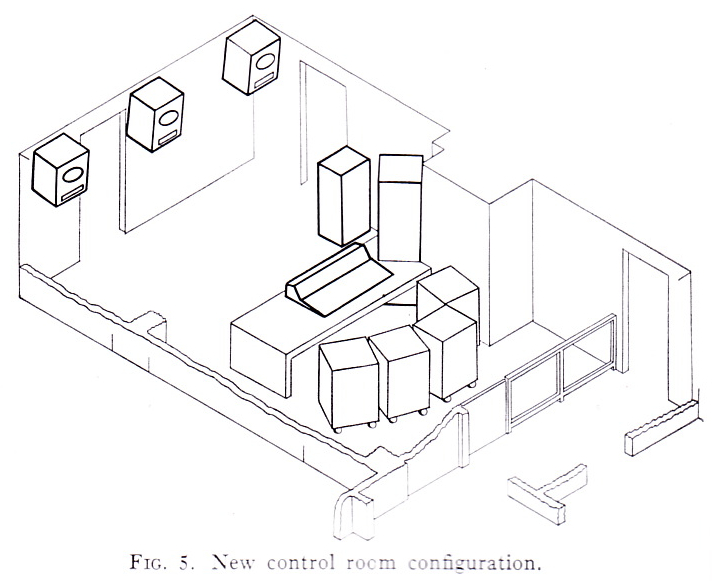 Capitol Records Studio A, New York, 1963.
Capitol Records Studio A, New York, 1963.
Capitol Records, like most big record companies of the fifties and sixties, had their own state-of-the-art recording studios: and on both coasts, no less. I am currently in the process of building a bespoke audio piece for a busy New York studio at the moment. My client is fairly unique (these days) in that they are a very well-equipped, full-scale label studio – a recording studio owned and operated by a record label and used by many of the label’s artists to record and mix their albums. This concept makes sense to me, as I worked for a decade for Sony Music in New York and spent at least half of that time at their enormous studio complex on West 54th street. The label-studio is becoming a thing of the past, but so is the traditional record-label business model. It will be interesting to see what ‘record companies’ evolve into in the next few decades, and whether or not the ‘means of production’ become more or less a part of this new business model.
14 replies on “Capitol Records Studios Circa 1960”
I have been looking for photos fo Capitol Records Studios in NYC for 10 years. Are there any more pics available? I recorded here with my band The Age Of Reason in 1966. I was told the board was an all tube Angus?
Recorded there in 1968-69 ! band was “the Head Shop”, w/ self titled album. By that time I vaguely remember the board was a 16 ch (State of the Art!) StudioMaster?
Would also love to see some pics.
I purchased a Fairchild 660 Limiter in 2006 that was purchased from Capitol records studios in NYC when they closed their doors. Just trying to find the actual date that studio closed. I believe it was sometime in 1976 or 1974.
Thanks
Jon
It would appear to have been 1971, because I recall this to be the last year Billboard‘s International Buyer’s Guide cited 165 West 46th Street as the NYC address for Capitol’s studios. If based on the 1972 guide, by then Capitol moved its mastering facilities to its (then-) East Coast corporate HQ at 1370 Avenue of the Americas. Certainly in that year, the Scully model 601 lathe which cut lacquers with ‘P’ and ‘T’ codes (as in lacquer numbers ending in -P1 or -T2 on the deadwax) was retired and replaced with a solid-state Neumann VMS-66 lathe with an ‘R’ code. The last year that lacquers were cut by the New York studio (with the ‘R’ Neumann plus the last remaining Scully 601 that cut lacquers with ‘W’ and ‘X’ codes) would have been 1974 or 1975, largely confined to record club (by then owned by Longines), Scholastic (for the children’s market), and Angel and Seraphim classical releases by then.
Hi Jon, small world! For anyone else interested in the gear I purchased from Capitol back in 1977 (thanks to their Chief Engineer, Richard Blinn, a friend of ours who helped me choose from a roomful shipped to LA after they closed the NY studio) I still have a few items left, included here: http://www.flickr.com/photos/mjl-kml/collections/72157629173146731/
I too would love to see more photos, get more info, and get in touch with anyone who knows more about the NY studio. I also bought a file cabinet that still contained the A-Z files of artists who recorded and/or were mastered at the studio, from Cannonball Adderley, Woody Allen, the Beach Boys, and Beatles to Frank Zappa. Anyone care to help create a book out of this? Some interesting stuff!
Yeah, I remember reading in Paul Anka’s biography that he recorded his first “hit” Diana there with producer\arranger Don Costa…I would like to see more pics of it myself. I looked up the location on Google Earth, and see the old entrance to the studio…
The Capitol Console from New York originally came with 16 Langevin 5116
It also had Astrodata solid state amplifiers 3 per card from 1962 that drove the
console over 72 amps in all
Would anyone know the engineers name or names that would have worked there in September 1966?
@LarryRussell – My father (Donald Trauscht) was president of Langevin from 64-67, during which time they supplied Capitol Records with a variety of equipment, consoles in particular. We only recently became aware of the legacy of that equipment, and I’m trying to learn more about it. My father passed away very recently, and I don’t think he ever grasped the significance of what he did during those years. I’m still learning myself.
Sorry to hear about Dad. I was only sixteen when I recorded drums there with my band The Age of Reason. I remember it like yesterday.
I just finished listening to “Basie meets Bond”.
That was the most enjoyable recording I have heard since 1955.
Thank you .
Peter Stirbis
Albuquerque, New Mexico
I just finished listening to “Basie meets Bond”.
That was the most enjoyable recording I have heard since 1955!
It is so good to see the old Capital Studio A once again. I recorded a single for Capitol there way back in 1971 that was never released, but I worked in that space many times later when it became Sound Ideas. By then I was a free lance jingle singer and remember Geoff Daking, now of Daking Audio, was often the engineer.
I have all of the blueprints to the console